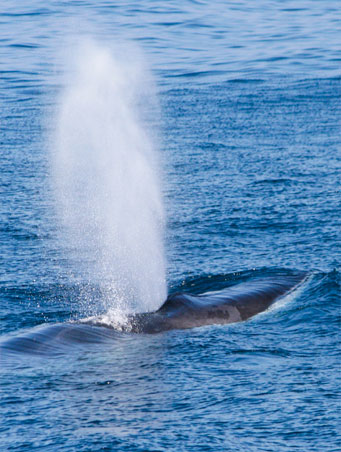The sperm whale is easily recognisable by its massive heads which contains the spermaceti: the world’s most powerful natural sonar or echolocation system. The single S-shaped blowhole is asymmetrically situated on the front of the head and to the left.
Sperm whales are mostly dark grey and present an extreme sexual dimorphism: a male can be 40% longer and weight 3 times as much as an adult female.
The lower jaw is much narrower than upper and can be opened nearly perpendicular to the body. Upper lips, lower jaw and interior of the mouth often are white. They have small and paddle-shaped flippers, and broad and triangular flukes.


Sperm whales can eat about 3 to 3.5% of their body weight per day. A standard diet consists mainly of deepwater squid including the giant squid and jumbo squid. The advantage is that squids rarely have predators in the deep waters, which allows the sperm whale to get an abundant food source. When foraging, they make repeated deep dives interspersed with rests to breathe on the surface. During the dives they use echolocation to find prey. Dives can last up to 2 hours and up to 3000m of depth In the Mediterranean, the sperm whales have a dive cycle of approximately 45 minutes dive duration, 9 minutes surface period.
Sperm whales have two prevailing types of behaviour: foraging and socializing. Adult males tend to farage alone. Family units with females calves and young males forage together over distance of 1 Km or more. While resting or socializing at or near the surface the behaviour is variable. They can be very quite or more active emitting vocalization, rolling around and touching one another, breaching or lobtailng. A behaviour apparently unique to sperm whale is “drift diving”. They hang passively and upright in the water, with their heads up or down, just below the surface. They are probably sleeping.
Sperm whales reach sexual maturity between 9 to 21 years, depending on the sex. Mating can take place at almost any time of the year and gestation lasts from 14 to 16 months. Sperm whales measure about four meters in length at birth. Weaning happens after a minimum of two years. Females collectively take care for the offspring and alternate their dive to provide better baby sitting. Sperm whales can live up to 77 years.
The most likely threat to Sperm Whales in the Mediterranean is entanglement in high-seas swordfish and tuna driftnets, which has caused considerable and likely unsustainable mortality since the mid-1980s.
Other threats include:

The common bottlenose dolphin is most likely the best known of all cetaceans, figured in legends and being known since the ancient Greeks ...

The short-beaked common dolphin is a medium-sized dolphin, easily distinguishable by a very unique hourglass-like pattern on the side of ...

The striped dolphin is the most abundant dolphin species in the Mediterranean Sea. It is a small, active and energetic dolphin, usually s ...

Risso’s dolphins are large members of the Delphinidae family, presenting a distinctive coloration that can vary throughout their ...

The fin whale is the second longest animal in the world, after the blue whale, reaching a length of 23 m and weighting up to 50 tons. The ...

The sperm whale is easily recognisable by its massive heads which contains the spermaceti: the world’s most powerful natural sonar or ech ...